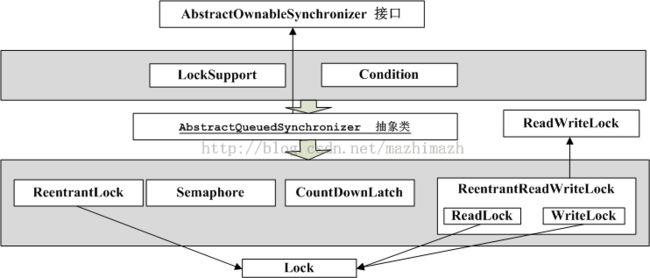Java 7之多线程第7篇 - 线程锁基础
线程锁是用来实现同步机制的,前面讲到过使用synchronized关键字来实现同步。
传送门 - 使用Synchronized关键字实现同步 http://blog.csdn.net/mazhimazh/article/details/16921255
使用这个关键字实现的同步块有一些缺点:
(1)锁只有一种类型
(2)线程得到锁或者阻塞
(3)不能实现很好的并发
为了解决如上的各种问题,后来又提出了一种更为复杂的锁 - 线程锁。线程锁可以在几个方面进行提升:
(1)添加不同类型的锁,如读取锁和写入锁(主要实现类为ReentrantReadWriteLock类)
(2)对锁的阻塞没有限制,即可以在一个方法中上锁,在另外一个方法中解锁。
(3)如果线程得不到锁,比如锁由另外一个线程持有,就允许该线程后退或继续执行,或者做其他事情 - 使用类中提供的tryLock()方法
(4)允许线程尝试取锁,并可以在超过等待时间后放弃。
下面来认识一下一个简单的线程锁 - Lock锁。简单的用法如下:
public class Counter{
private Lock lock = new ReentrantLock();
private int count = 0;
public int inc(){
lock.lock();
int newCount = ++count;
lock.unlock();
return newCount;
}
}
由于++count包括读取、自增、赋值操作,所以为了保证能够原子执行,使用了Lock锁。
Lock锁的功能很强大,不过他的实现复杂了不少。锁的实现源代码主要在java.util.concurrent.locks包下,先看看锁的框架图,如下所示。
注:如上的粗箭头表示,下面类的实现依赖于上面类的实现。例如,AbstractQueueSynchronizer抽象类的实现依赖于LockSupport和Condition类。
1、Lock接口
Lock接口中定义的方法如下:
public interface Lock {
void lock(); // 获取锁
void lockInterruptibly() throws InterruptedException; // 如果当前线程没有被打断,则获取锁
boolean tryLock(); // 如果在调用的时候能锁没有被其它线程持有就获取这个锁
boolean tryLock(long time, TimeUnit unit) throws InterruptedException; // 在给定的时间内获取到锁
void unlock(); // 释放锁
Condition newCondition(); // 得到Condition实例
}
2、AbstractOwnableSynchronizer接口
public abstract class AbstractOwnableSynchronizer implements java.io.Serializable {
protected AbstractOwnableSynchronizer() { }
private transient Thread exclusiveOwnerThread;// 独占锁的持有线程
// 提供锁的setXxx()和getXxx()方法
protected final void setExclusiveOwnerThread(Thread t) {
exclusiveOwnerThread = t;
}
protected final Thread getExclusiveOwnerThread() {
return exclusiveOwnerThread;
}
}
3、下面来介绍一下几个需要重点理解的概念
1>. AQS -- 指AbstractQueuedSynchronizer类。
AQS是java中管理“锁”的抽象类,锁的许多公共方法都是在这个类中实现。AQS是独占锁(例如ReentrantLock)和共享锁(例如Semaphore)的公共父类。
2>. 队列
队列是AQS中“等待锁”的线程队列。在多线程中,为了保护竞争资源不被多个线程同时操作而起来错误,我们常常需要通过锁来保护这些资源。在独占锁中,竞争资源在一个时间点只能被一个线程锁访问;而其它线程则需要等待。队列就是管理这些“等待锁”的线程的队列。
队列是一个非阻塞的 FIFO 队列。也就是说往里面插入或移除一个节点的时候,在并发条件下不会阻塞,而是通过自旋锁和 CAS 保证节点插入和移除的原子性。
来看一下队列的Node节点源代码,如下:
static final class Node {
static final Node SHARED = new Node();// 共享锁
static final Node EXCLUSIVE = null; // 独占锁
// 定义waitStatus值
static final int CANCELLED = 1; // 线程已被取消
static final int SIGNAL = -1; // 当前线程的后继线程需要被unpark(唤醒)
static final int CONDITION = -2; // 处在Condition休眠状态的线程在等待Condition唤醒
static final int PROPAGATE = -3; // 其它线程获取到共享锁
/**
* Status field, taking on only the values:
* SIGNAL: The successor of this node is (or will soon be)
* blocked (via park), so the current node must
* unpark its successor when it releases or
* cancels. To avoid races, acquire methods must
* first indicate they need a signal,
* then retry the atomic acquire, and then,
* on failure, block.
* CANCELLED: This node is cancelled due to timeout or interrupt.
* Nodes never leave this state. In particular,
* a thread with cancelled node never again blocks.
* CONDITION: This node is currently on a condition queue.
* It will not be used as a sync queue node
* until transferred, at which time the status
* will be set to 0. (Use of this value here has
* nothing to do with the other uses of the
* field, but simplifies mechanics.)
* PROPAGATE: A releaseShared should be propagated to other
* nodes. This is set (for head node only) in
* doReleaseShared to ensure propagation
* continues, even if other operations have
* since intervened.
* 0: None of the above
*
* The values are arranged numerically to simplify use.
* Non-negative values mean that a node doesn't need to
* signal. So, most code doesn't need to check for particular
* values, just for sign.
*
* The field is initialized to 0 for normal sync nodes, and
* CONDITION for condition nodes. It is modified using CAS
* (or when possible, unconditional volatile writes).
*/
volatile int waitStatus;
volatile Node prev;
volatile Node next;
volatile Thread thread; // 节点对应的当前线程
Node nextWaiter;
// 共享锁则返回true,独占锁则返回false。
final boolean isShared() {
return nextWaiter == SHARED;
}
// 如果有的话,返回前一个节点
//predecessor引用的作用是为了支持锁等待超时(timeout)和锁等待回退(cancellation)的功能
final Node predecessor() throws NullPointerException {
Node p = prev;
if (p == null)
throw new NullPointerException();
else
return p;
}
// --------几个构造函数----------------------------------
Node() { }
Node(Thread thread, Node mode) { // Used by addWaiter
this.nextWaiter = mode;
this.thread = thread;
}
Node(Thread thread, int waitStatus) { // Used by Condition
this.waitStatus = waitStatus;
this.thread = thread;
}
}// end Node
/* CLH是一个非阻塞的 FIFO 队列。也就是说往里面插入或移除一个节点的时候,在并发条件下不会阻塞,而是通过自旋锁和
* CAS 保证节点插入和移除的原子性
*/
private transient volatile Node head;
private transient volatile Node tail; 举一个操作,向队列末尾插入元素时的操作如下:
// 向队列中插入Node节点
private Node enq(final Node node) {
for (;;) {
Node t = tail;
if (t == null) { // Must initialize
if (compareAndSetHead(new Node()))
tail = head;
} else {
node.prev = t;
if (compareAndSetTail(t, node)) {
t.next = node;
return t;
}
}
}
}
3>. CAS函数 -- Compare And Swap
CAS函数,是比较并交换函数,它是原子操作函数;即,通过CAS操作的数据都是以原子方式进行的。例如,compareAndSetHead(), compareAndSetTail(), compareAndSetNext()等函数。它们共同的特点是,这些函数所执行的动作是以原子的方式进行的。
如果对他们的原理不怎么理解,可以查看:传送门 - http://blog.csdn.net/mazhimazh/article/details/18908493
